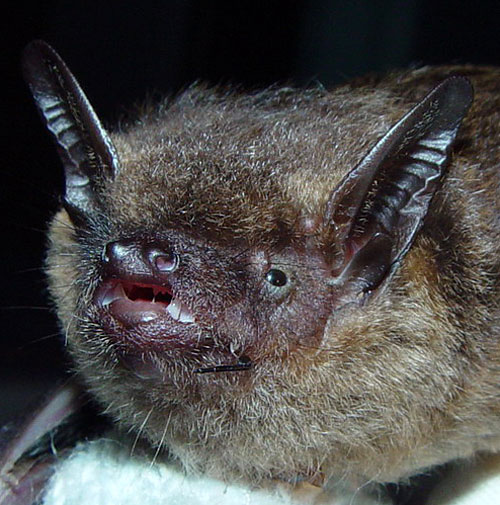Eptesicus serotinus
Common serotine
Da ZongfuMorphological description Life history Distribution Habitat Roost sites and roosting patterns Emergence and flight pattern Foraging behaviour Echolocation calls Status and protection
Photo by Shiang-Fan Chen, Taiwan
Morphological Description
· Dorsal fur is dark brown. Ventral fur is variable, ranging from black to brownish-white.
· Forearm length 49-57mm.
·Tragus relatively thin and pointed: not kidney shaped as in Nyctalus.
Life history
· In Britain this species mates in September and October, and maternity colonies build up in May. Few nulliparous females in maternity roosts suggests maturation in first year. For more details see Harris & Yalden (2008).
Distribution
·Palaearctic between about 58 degrees and 30 degrees in west: east to China. Widely distributed across China, with 4 subspecies recognised. E. s. andersoni found in Anhui, Fujian, Guizhou, Hunan, Jiangsu, Jiangxi, Shanghai, Sichuan, Yunnan, Zheijang; E.s. horikawai in Taiwan (picture above); E.s. pallens Anhui, Beijing, Heilongjiang, Henan, Hubei, Gansu, Hebei, Jiangsu, Jilin, Liaoning, Nei Mongol, Ningxia, Shanxi, Shaanxi, Shandong, Sichuan, Tianjin; E.s. turcomanus Xinjiang (Smith & Xie 2008).
Habitat
· In Britain, feeds often around trees and over pasture (detail in Harris & Yalden 2008).
Roost sites and roosting behaviour
· In Taiwan roosts, sometimes in large numbers in low altitude tunnels and bridges. Also found roosting at base of betel nut palm leaves and in abandoned swallow nests (Lin et al. 2004). Data below for Britain.
- Summer roosts: females are found in nursery roosts of 15-30 individuals from March to the end of August (Hutson 1991). Males are solitary throughout the year. Roost in old buildings dating to pre-1900 with cavity walls.
- Robinson & Stebbings (1997) found that the nursery roosts of serotines that contained less than 20 individuals had home ranges of 24-77 square km, with central areas of high activity of 13-33 square km. There was an average density of one bat per 120 hectares, although this density would be higher had the non-breeding and juvenile bats been included in the calculation. Serotine travelled an average of 8 km a night between their foraging sites.
- Winter roosts: cavity walls, chimneys and under the floors of old buildings and caves.
- Occasionally found in tree holes and rarely bat boxes.
- May share roosts with pipistrelles.
Emergence and flight pattern
· An edge species which flies often along tree lines.
Data below for Britain:
- Median emergence time is 20 minutes after sunset (Jones & Rydell 1994).
- Serotines alter their emergence pattern seasonally. Catto et al. (1995) found that in early summer the activity of serotines was unimodal. When the bats were pregnant the activity became bimodal, and from mid-lactation the activity was multimodal. After lactation patterns then returned to unimodality. These findings indicate that reproductive state can affect activity patterns. Low temperatures were found to suppress activity.
- Flies slowly and leisurely, but agile.
- Flies up to 30m above ground level (Hutson 1991).
- Flies mainly at treetop height to foraging site.
- At the start of the season the bats return to their roosts 30-40 minutes after their first emergence (Hutson 1991).
- Petrzelkova & Zukal (2003) found that the presence of a barn owl outside the roost at the time of emergence had no effect on the emergence pattern of serotines, with the exception of their clustering behaviour. Pregnant bats clustered more closely when emerging when a barn owl was present and continued to cluster for several subsequent nights. This suggests that clustering on emergence is a predation avoidance strategy.
Foraging behaviour
·Data below for Britain:
- Foraging activity peaks at the start of the night, and there is a second period of activity around dawn.
- Serotines commute on average 6.5km to and from feeding areas per night, and use up to 5 areas each night. Serotines use three main feeding strategies: short flights, ground feeding and mainly aerial hawking (Catto et al. 1996).
- Forages 0-5m above ground level (Russ 1999).
- The diet of serotines mainly consists of Coleoptera, with both crepuscular and diurnal species being eaten. Tympanate species are also taken. Lepidoptera and Diptera are also part of the serotine's diet. Hawking and gleaning foraging strategies are used (Vaughan 1997).
- Robinson & Stebbings (1993) investigated the diet of the serotine. They found that in 96.1% of the faeces they examined Coleoptera were present and in 14.7% Lepidoptera were present. The beetle species found were from habitats such as hay meadows or grazed pasture indicating that this population of serotines foraged mainly over these habitat types.
- Catto et al. (1994) found that the most common prey item of serotines was Aphodius beetles. The bats consume the greatest diversity of prey items in June.
Echolocation calls
·Data below for Britain:
Average values for a serotine echolocation call, as given by Vaughan et al. (1997), are listed below:
Interpulse interval: 116 ms
Call duration: 5.22 ms
Minimum frequency: 27.7 kHz
Maximum frequency: 57.4 kHz
Prior to emergence social calls are made for approximately half an hour.
Status and protection
· In China considered RL-LC. Globally Least Concern , population trend unknown (IUCN 2008).
· Houses and buildings should be protected as important roost sites. Treelines and hedgerows may be important for commuting and feeding.
